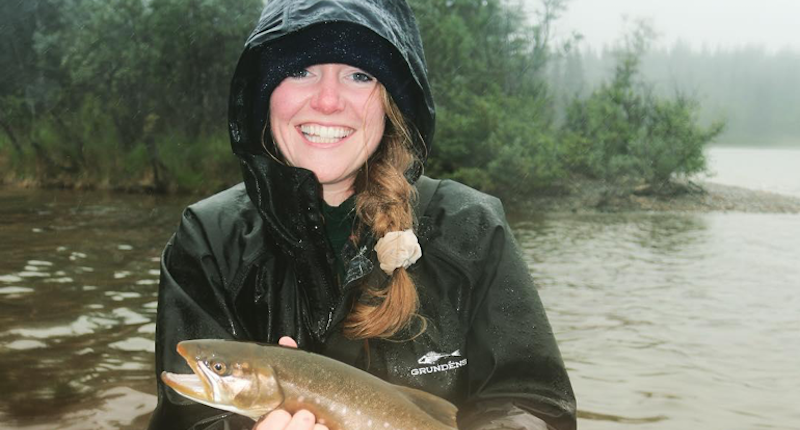NCEAS Portrait: Sarah Inman on What it Means to Be a Data Ethnographer

Sarah Inman studies people who are studying salmon. As a data ethnographer on the State of Alaska’s Salmon and People project (SASAP), a collaboration between NCEAS and Nautilus Impact Investing, she has the unique role of tracing how the project’s scientists collaborate with each other - an exploration that will not only help increase research efficiency, but could also help improve scientists’ communication with managers and policy makers.
Most recently, Inman has been applying her approach to SASAP’s Data Task Force, a team of data scientists that compiles salmon data from scientific, managerial, and Native Alaskan sources, then cleans and organizes the data to make them useful for others. Inman, who is a PhD student in the University of Washington’s department of Human-Centered Design and Engineering, has been studying the research practices involved in this effort - the data collection, archival, and sharing; and the communication between researchers.
Tracing the flow of information between the project's people and institutions will allow Inman to reveal how data is made accessible, how knowledge is distributed amongst people in the study, and ultimately, how data is made useful later.
“This has included more traditional ethnographic studies, such as following how data are produced in field ecology, to more trace ethnographic studies, such as exploring the communication that occurs on GitHub amongst the Data Task Force team,” explained Inman.
Inman is more than a scientific observer of the SASAP project; her expertise in social science and passion for ecology drove her to join the project's working group that is evaluating whether local native and non-native Alaskan communities feel they have a voice in salmon management through activities like community-based monitoring.
By revealing how both researchers and citizens share knowledge with each other, Inman’s research is poised to contribute to the project’s larger goals – to facilitate equitable, data-supported decision-making that will sustain salmon and the human lives that depend on them.
In this month’s NCEAS portrait, Inman shares her experience studying the social dimensions of environmental data science.
Can you explain a little more about how are you applying your disciplinary perspective to understand the data synthesis work involved in SASAP?
SI: My primary interest is in the social dynamics of how people in organizations work together and the technological factors that have inhibited or facilitated their collaboration. Specifically, I have been following how individuals discover and attend to errors or uncertainties in data, how people in different disciplines use historical data, and how data is made legible to natural resource managers.
Why is studying the “user experience” of data within research groups important?
SI: Data cleaning and archiving can be seen as an effort of remembrance — identifying and saving important information about the context of the original discovery and technology. In other words, what we count, save, and consider as “data” are things we value at a certain point in time. However, synthesizing so much information also demands that some things fade into the background. Studying this process within active groups helps reveal some of the labor that is often invisible in the final product.

SASAP data has been compiled from many organizations, all of which have different institutional structures and data collection methods. How is someone with your expertise equipped to address the challenges of working with disparate data?
SI: My expertise is looking specifically at those challenges. Much of my focus has been on the social dynamics of responding to challenges associated with data synthesis, like differing data standards between organizations and preserving the perspective and engagement of the data collectors themselves. One thing that makes me equipped to address these challenges is that I am an outsider. Some of the norms within the various disciplines seemed peculiar to me and enabled me to ask different questions than would perhaps occur to someone within the field.
What have you been learning from your ethnography of the Data Task Force’s use of Github?
SI: I have learned more about the amount of work that is left out of the formal process – particularly, how much is learned about salmon by data archivists as they identify and fill information gaps during the data quality assurance and control process. Another interesting aspect is how institutional knowledge is distributed throughout networks of people, often people who aren’t formally involved in the group, such as the original data collectors or long-standing data managers. If we hope to ultimately use archival data resources to answer important questions about our environment, we need to include their knowledge as a major component of data synthesis.
What impact do you hope SASAP and your contribution to the project will have?
SI: I hope to shed light on the invisible labor of data production and cleaning practices while helping represent this work more accessibly with data visualization and communication methods – not only in the data science context, but also for those in the field collecting data all season long. I also hope that my work will speak to how to include those who are not typically considered in academic research.
###
NCEAS Portraits feature the people behind our work and impact.
